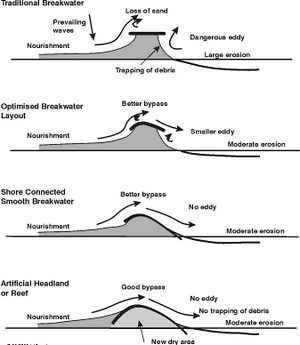Difference between revisions of "Template:This weeks featured article"
(→Optical measurements in coastal waters) |
(→Application of breakwaters) |
||
| Line 1: | Line 1: | ||
| − | == | + | ==Application of breakwaters== |
| − | [[Image: | + | [[Image:artifical headland.jpg|300px|thumb|Fig. 2. Optimisation of coastal breakwater to artificial headland, applicable for moderately exposed to exposed coasts for small angles of incidence.]] |
| − | [[ | + | Breakwaters aim to protect a coast or activities along the [[coastline]] (e.g. ports, ship wharf) from wave action. Different types of breakwaters exist, from which [[detached breakwater]]s are the most common type of breakwater. This article provides a general introduction of breakwaters and describes submerged or low-crested breakwaters, floating breakwaters and special type breakwaters. The characteristics and application of [[detached breakwater|detached breakwaters]] are described in other articles: [[Detached breakwaters]], [[Applicability of detached breakwaters]] and [[Detached shore parallel breakwaters]]. |
| + | |||
| + | Breakwater schemes have many variables, which determine the impact on the shoreline. The variable parameters are outlined in the following: | ||
| + | *Emerged, submerged or floating | ||
| + | *Distance from shoreline and location relative to the [[surf zone]] | ||
| + | *Length and orientation | ||
| + | *Single or segmented | ||
| + | *Special shapes | ||
| + | |||
| + | There are further descriptions in the article [[Detached breakwaters]] for combinations of all these parameters. | ||
| + | |||
| + | A shoreline management breakwater serves two purposes: | ||
| + | *To provide shelter from the [[waves]] | ||
| + | *Through this shelter, to manipulate the littoral transport conditions and thereby to trap some sand | ||
Revision as of 11:29, 5 January 2009
Application of breakwaters
Breakwaters aim to protect a coast or activities along the coastline (e.g. ports, ship wharf) from wave action. Different types of breakwaters exist, from which detached breakwaters are the most common type of breakwater. This article provides a general introduction of breakwaters and describes submerged or low-crested breakwaters, floating breakwaters and special type breakwaters. The characteristics and application of detached breakwaters are described in other articles: Detached breakwaters, Applicability of detached breakwaters and Detached shore parallel breakwaters.
Breakwater schemes have many variables, which determine the impact on the shoreline. The variable parameters are outlined in the following:
- Emerged, submerged or floating
- Distance from shoreline and location relative to the surf zone
- Length and orientation
- Single or segmented
- Special shapes
There are further descriptions in the article Detached breakwaters for combinations of all these parameters.
A shoreline management breakwater serves two purposes:
- To provide shelter from the waves
- Through this shelter, to manipulate the littoral transport conditions and thereby to trap some sand
